-
Posts
11,151 -
Joined
Content Type
Profiles
Forums
Store
Help Articles
Posts posted by slkinsey
-
-
Start with good ricotta (not the watery Polly-O crap), a few egg yolks, flour and, if you're me, plenty of nutmeg. Mix into a light dough, adding just enough flour to bind it together.
Get a guy with thick fingers and hairy forearms to flick each piece over the tines of a dinner fork, and then you're done. Toss them into boiling water and they're done when they float to the top.
Sam - how much flour, and how many yolks would you estimate for a pound of ricotta?
Like many cooking tasks, after you've done it a while it becomes a "by feel" sort of thing. So I can't really say how much flour and egg yolks for a pound of ricotta. This is all the more true because regular supermarket ricotta has substantially more water content than the almost-as-thick-as-cream-cheese ricotta I'm using. If I had to guess, I'd say something like 1 pound of thick ricotta (drain the supermarket stuff overnight), plus two egg yolks, plus 2/3 cup flour. The idea is to add maybe half of the flour and stir the mixture a few times, and then add in just enough flour to make it come together as a light dough.
For ethereal potato gnocchi, I just don't understand the need for anything but potatoes (yukon work best) and flour -- stop.I agree with Joe, although I prefer to add just the tiniest grating of fresh nutmeg. The less flour you use, the lighter the gnocchi will be. There are some practical limitations, however. I have made potato gnocchi that, while perhaps a technical feat, were really too light and delicate to be satisfying. Choice of potato variety is also of primary importance if you want to make gnocchi with no other binders. Best is something in between a floury variety and a waxy variety. Yukon Gold are good in this respect, and I've had even better results with Yukon Gold creamers ("creamers" are potatoes harvested in the earliest stages of growth, before they are mature). I've never tried gnocchi with any "heirloom potatoes" one finds in the greenmarkets, but it might be an interesting experiment.
There is also the method of cooking to be considered. Standard practice is to boil the potatoes, but some people swear by baking, which reduces the moisture content and supposedly requires less flour as a result.
Anyone have thoughts on stuffed potato gnocchi? Some of the best I've ever had were stuffed with meat and peas. Another interesting potato gnocchi variant is chestnut gnocchi, made with potato and a mixture of wheat flour and chestnut flour (although I suppose it might be interesting to try making them with a puree of cooked chestnut meat and flour). Excellent with a duck and porcini ragù.
-
Pounce, I don't think plantains work that way. If you cook a green plantain, the starches aren't going to be converted into sugars. Starches (mostly) turn to sugars when they are broken down by enzymes. That's what happens as the plantain ripens. So, what you are proposing would be like cooking an unripe apple sous vide and thinking it will become sweeter through the cooking (which I think we would agree won't work).
A green plantain cooked sous vide will turn out, I am guessing, much like a potato cooked sous vide. Not sure there would be much point to it.
Green plantains, I should point out, have an unusual property in that they do not reheat very well at all. A freshly boiled piece of green plantain is soft whereas a piece of boiled plantain that has cooled and reheated is dense and hard.
-
This sounds like it's right up my alley! I'll make a few different ones, probably starting with ricotta gnocchi (because they're so easy). I'll make a more detailed post this time around, but here is a little ricotta gnocchi action from one of my foodblogs for anyone who might be interested in trying it out:
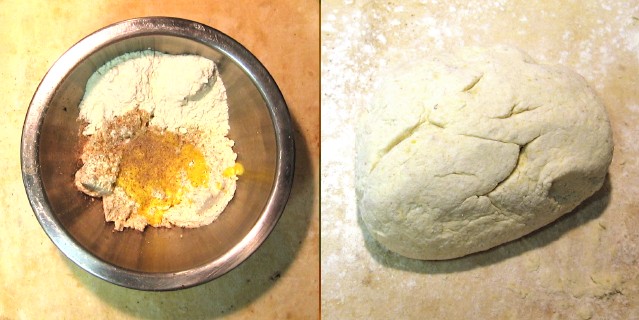
Start with good ricotta (not the watery Polly-O crap), a few egg yolks, flour and, if you're me, plenty of nutmeg. Mix into a light dough, adding just enough flour to bind it together.
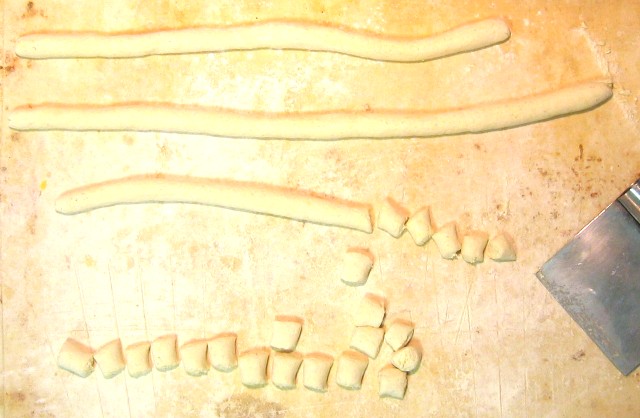
Roll the dough into cylinders and cut it into pieces.
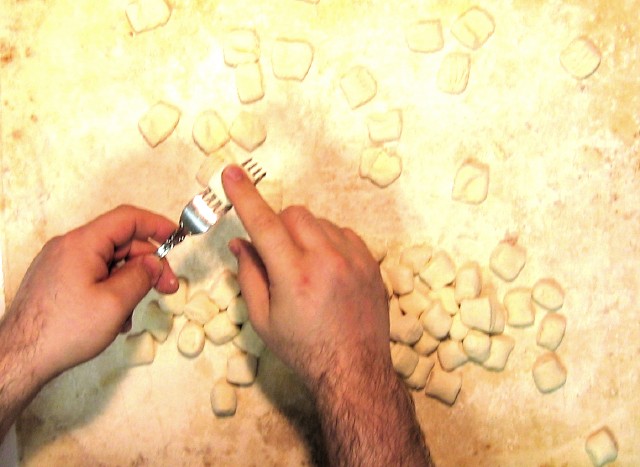
Get a guy with thick fingers and hairy forearms to flick each piece over the tines of a dinner fork, and then you're done. Toss them into boiling water and they're done when they float to the top.
-
Fair enough. I've been trying a lot of gins "off the beaten path" lately. Most recently has been Barton gin, which really seems rather unusual. The aroma is difficult to place, and the flavor is very light on the juniper. I was wondering if anyone had any information on it? Tasting notes? Botanicals involved? Knew whether it was a gin head, compound, or maceration gin?
Barton gin is a rock bottom "value priced" gin, made by the same American company that makes Fleischmann's. Barton is even less expensive than Fleischmann's, if you can believe that, coming in at around nine bucks a liter. This means that it is almost certainly a compound gin. And if it has a light juniper taste and "unusual" flavor profile, this is undoubtedly more a result of corner cutting and less-than-premium ingredients and techniques than anything else.
-
Not wanting to appear too eager, Chris and Gary had arrived at Pegu a full five minutes late for the relatively small gathering of “friends and family” who were invited to a sneak preview of the club on Wednesday, August 24. And as they expected, they were not the first people there. But nobody had ordered a drink yet. What were they thinking? Why the hell were they there? Oh, it’s true that everyone in attendance that night showed up to support Audrey and the clan, but this was Pegu Club, Goddamit. And Audrey’s cocktails were to be had. For free.
Although they are usually very shy about this sort of thing Chris and Gary wasted no time. They hailed bartender Chad Solomon and demanded Pegu Club cocktails. Chad obliged. The drinks were heavenly. Pure bliss. And they were the first. The very first.
-
On the menu, the regular cocktails are $12 and the champagne cocktails are $16. These are fairly standard prices for cocktails of this quality and in this kind of setting, if perhaps a little bit on the low side. For comparison purposes, cocktails at The Double Seven are running $16 (although they may come in a bigger glass).
-
Hi Matthew. I'll have some more detailed things to say about Pegu Club after opening. One thing that did impress me, however, is how "ready" they already were at the pre-opening events -- far more so than most restaurants.
You should, of course, try the house cocktail: The Pegu Club Cocktail. Another one that I think is very interesting, and which I can confidently say you're unlikely to find in any other bar, is the Jimmie Roosevelt. But just tell the bartenders what you like, and they'll be happy to recommend something for you. Think of everyone behind the bar as a "cocktail sommelier."
-
Cool! I recently had an Improved Holland Gin Cock-Tail from someone's stash of Bols. I'll be interested to hear how it works with Boomsma. Remember, though, that you want to use Jonge and not Oulde for this drink.
-
... does there exist an premium herbal market .. like it is at vodka or gin?
I don't think you're going to find what you're looking for if you want something like the "superpremium" vodka market. This is because the premium vodka market is high volume and largely about marketing. It's not like Van Gogh is inherently a better vodka than Luksusowa simply because it comes in a fancy bottle and costs twice as much. The market for herbal liquor is just not that way. Especially since the majority of herbal liqueurs, digestivi, etc. tend to be more or less unique and not directly comparable to other brands. It's not even like the fruit liqueur market, where there are leading brands (e.g., Cointreau) and lesser brands (e.g., all the other triple sec brands). Are you thinking of something like a special superpremium version of Campari that costs three times more than regular Campari? The Chartreuse V.E.P. bottlings are the only ones like that of which I am aware.
-
I've used debit cards for years, and don't think I've ever seen a charge on my statement for X dollars followed by a credit for y from the same transaction. My larger point, though, was that banks don't need to do tricky things to put your money in an "interest bearing account" and make money. First off, who would be paying the interest anyway? What happens is, for example, you and 10,000 other people have checking accounts in a bank to the tune of $5,000 dollars each. That's $50,000,000. Now they're not just going to sit on that money. They're going to take some of it and buy bonds, they're going to take some of it and make loans to homeowners and businesses, they're going to take some of it and use it to pay businesses when their cardholders make credit card purchases, etc. At any given time, the actual liquid funds available to the bank are likely to be substantially less than $50,000,000 because they're out there making money with most of it. But even though the bank is technically taking some of your money that you have on deposit and using it for something, they're not going to reduce the balance of your account. They don't have to. They can just use the money and tell you that you have $5,000 on deposit. If you wanted all of your money, they would have enough liquid funds to give you your five grand. If all 10,000 customers wanted their $5k, the bank would be screwed and FDIC would have to pay whatever the bank couldn't pay.
So the reason the bank doesn't have to do something sneaky to move your money into a different account for a few days in order to make money off it, is that they're already using as much of your money as they're allowed to use anyway.
-
Marsha, it's not the math so much as it is that I don't think that's quite how it works.
Please someone correct me if I'm wrong (estufarian would probably know), but according to my understanding this is what happens when you make a credit card transaction at a restaurant.
1. I get a bill for $100 at a restaurant and hand over my credit card. My credit card has $500 of free credit remaining.
2. The restaurant swipes the card, the terminal goes online and seeks authorization for $120 in anticipation of an approximately 20% tip.
3. Your bank then "reserves" $120 on your credit account. Your free credit is now $380.
4. You add whatever it is that you're going to tip (let's say it's $18) and sign the bill.
5. Eventually, the restaurant runs the transaction in the amount of $118. This is reconciled by the back end systems. $118 is charged on your credic account, the extra $2 of "credit hold" is released, and your free credit is now $382.
Let us say, for the sake of argument, that it takes two days for the reconciliation to happen and for your effective free credit to go up by two dollars. Who is earning money from this? The bank doesn't have an extra two dollars of your money. They can't start charging you interest on the restaurant charge until it reconciles and the $118 charge actually hits your account. All they are doing is saying that there is two dollars worth of credit that they won't let you use for two days. The interest on that two dollars is zero, because it's not money -- it's money that you haven't borrowed yet. In fact, by preventing you from borrowing those two dollars, the bank is depriving itself of the potential to make money from the interest on those two dollars.
Now, in terms of a debit card, it's not clear to me that the bank is taking that two dollars out of your account and then putting it back in when the reconciliation happens. Rather it may be that the bank is saying that you can't take that two dollars out until the reconciliation happens. Or rather, much like with the credit situation, they're saying that you can't take out twenty dollars until they find out just how much the bill actually is and do the reconciliation.
But here's the thing: tha Bank doesn't need to take the money out of your account and park it in a general ledger to make a profit from your deposits. They're already lending your money out to other people and charging them interest even while it's sitting in your account. That's how they make their real money.
-
It's got to be Chartreuse V.E.P. (Vieillissement Exceptionnellement Prolongé -- "Exceptionally Prolonged Ageing"). Goes for about a hundred bucks a liter.
-
Personally, I don't think I'd want one of these and I wouldn't give one.
Far better, I think, to give make something up yourself. You want to give someone a "Martini kit?" Pick up small bottles of Tanqueray and Noilly Pratt, maybe a little jar of olives, find a cool mixing glass and a Hawthorne strainer, and put it together with The Martini Companion: A Connoisseur's Guide by Gary & Mardee Regan.
Or, if you want to make a more general "cocktail kit" there are other books you could use, etc.
-
Some pictures from yesterday's pre-opening party. These were taken by Jared Brown, who together with Anistatia Miller runs one of the internet's longest-running spirits and cocktails related web sites, Shaken Not Stirred.

The Pegu Club logo on a bar napkin.

A shot from the beginning of the bar towards the main seating area.
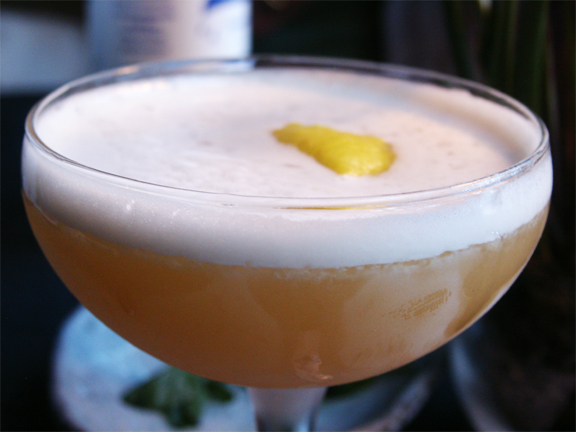
This is the kind of cocktail perfection you can expect at Pegu Club.
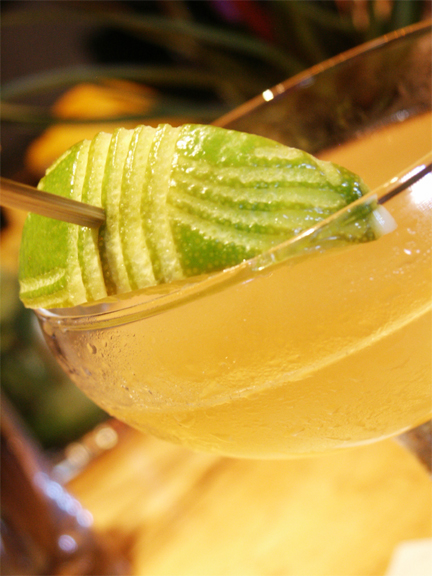
A look at the house cocktail.
-
But what is "pork miale"? A Yahoo search produced no results.
Why, it's "pig pork" of course.
 As opposed to other kinds of pork, one assumes. Kinds of like "shrimp scampi" in that respect. Maiale (my-AH-leh, for the record) is Italian for "pig," and is often used to mean "pork" ("carne di maiale).
As opposed to other kinds of pork, one assumes. Kinds of like "shrimp scampi" in that respect. Maiale (my-AH-leh, for the record) is Italian for "pig," and is often used to mean "pork" ("carne di maiale).It's an easy misunderstanding to make given Falai's menu layout, which looks like this:
Pollo chicken cooked in the pot,cipollini baby potatoes and fresh herbsMaiale pork filet with fennel seeds, cocoa nibs and potatoes purea
Manzo Beef medallions with sautéed spinach, raisin Brunello di Montalcino sauce
It would be very easy for a non-Italian-speaker to interpret "Pollo," "Maiale" and "Manzo" as the names of dishes rather than "chicken," "pork" and "beef." We are much more used to seeing things like this, where the name in bold would be the name of the preparation:
Risotto fresh peas, vialone nano rice and chicken stock
In that case, one would rightly call it "fresh pea risotto."
-
Lease difficulties have scotched Tony Luke's plans to move to a nearby location. So the Philadelphia cheese steak spot will stay where it is. It will reopen on Sept. 1
Title changed back accordingly.

-
Exactly. I have a hard time understanding how Spigolo is worth two stars while Landmarc is only worth one star (albeit, a Hesser star rather than a Bruni star).
-
Stagiaire, the oxtail dish sounds awesome. How warm did you serve it? Didn't the heat from crisping the breaded side in duck fat melt the gelatin (which I assume acted as the binder)?
-
I think it very much depends on which web site you're talking about. Some sites seem to let just about anyone post their opinions on a restaurant (or book or movie or whatever). No one has to join or register, the "reviwers" are largely anonymous, and you tend to get lots of relatively unqualified raves or pans. This, in my opinion, does amount to taking opinions from the person next to you in line. This is the case with london-eating.co.uk.
But, not all internet food sites are alike.
This is a big reason why we have always had registration, have encouraged people to disclose their real names, and have frowned upon/acted to prevent multiple registrations. By spending time reading these forums, people can begin to form an picture of what they think of other members' writing, opinions, expertise, etc. For example, I don't think it takes a rocket scientist to figure out that Fat Guy and Bux have more fine dining experience than I have. As a result, they may be able to offer opinions on certain aspects of certain restaurants from a more informed basis than I can. Or they may be able to suplement opinions and statements I may offer with information of their own during the course of discussion. This is among the reasons we like to have single-thread discussions about a given restaurant. Readers can see the history of member responses to a restaurant, can ask questions, and can read a multiplicity of opinions from many different perspectives. My opinion is that a reader can gain much more information about a restaurant from a good eG Forums discussion thread than from a 1,000 review in a newspaper -- especially given the fact that so many reviews are complete drek these days, from Bruni's "60% scene/40% food" reviews to the "bad boy reviewers"of the UK.
-
Exactly. A few vanilla beans (poke some small holes in them), liquor and time. I've done a vanilla-infused bourbon a time or two. Save the vanilla beans when you're done. You can scrape them out and use it in a dessert.
-
I have plenty of empathy for many reasons to not use credit cards, but as Bux points out, there are many everyday transactions that have simply become impossible without them.
-
More info as it comes in:
The official opening date is Monday, August 29th, 2005.
Hours will be:
Sunday ~ Wednesday: 5:00 p.m – 2:00 a.m.
(Snack menu offered until 1:00 a.m.)
Thursday ~ Saturday: 5:00 p.m. – 4:00 a.m.
(Snack menu offered until 3:00 a.m)
-
What is the deal with cooling after cooking? I'm not asking about cooling for storage, but rather for immediate service. Is there some culinary value to cooking, chilling and reheating? And, for meat, is there some value to going up to a target temperature and then backing off maybe 5 degrees to "rest" the meat still sous vide? Might this cause some of the exuded liquid to go back into the meat? I remember in another thread, someone who was cooking a prime rib LTLT (not sous vide) found that there was much better retention of liquid if the whole thing was brought down about 5 degrees after hitting the target temperature for doneness. This took quite a while, as I recall -- kind of a "LTLT rest."
-
If it's just ginger in vodka, you should be fine from a food safety standpoint given the relatively small amount of ginger you used. Unfortunately, you may find that it doesn't have the "zing" it had when it was fresh. Zingerone seems to be relatively volatile and doesn't stay around too long.



Need Help With Short Drink Recipe
in Spirits & Cocktails
Posted
Hi Rob.
What's the thinking behind mixing cognac with vanilla flavored sweetened cognac? Seems like you'll just get slightly less sweet, slightly less vanilla flavored cognac. Navan seems like a potentially interesting product, but if I were you I'd think first about changing base liquors. Navan with applejack seems like it might be interesting. And I'd definitely try it with gin, although that might be less successful. Maybe something like a Twentieth Century Cocktail with Navan instead of crème de cacao.